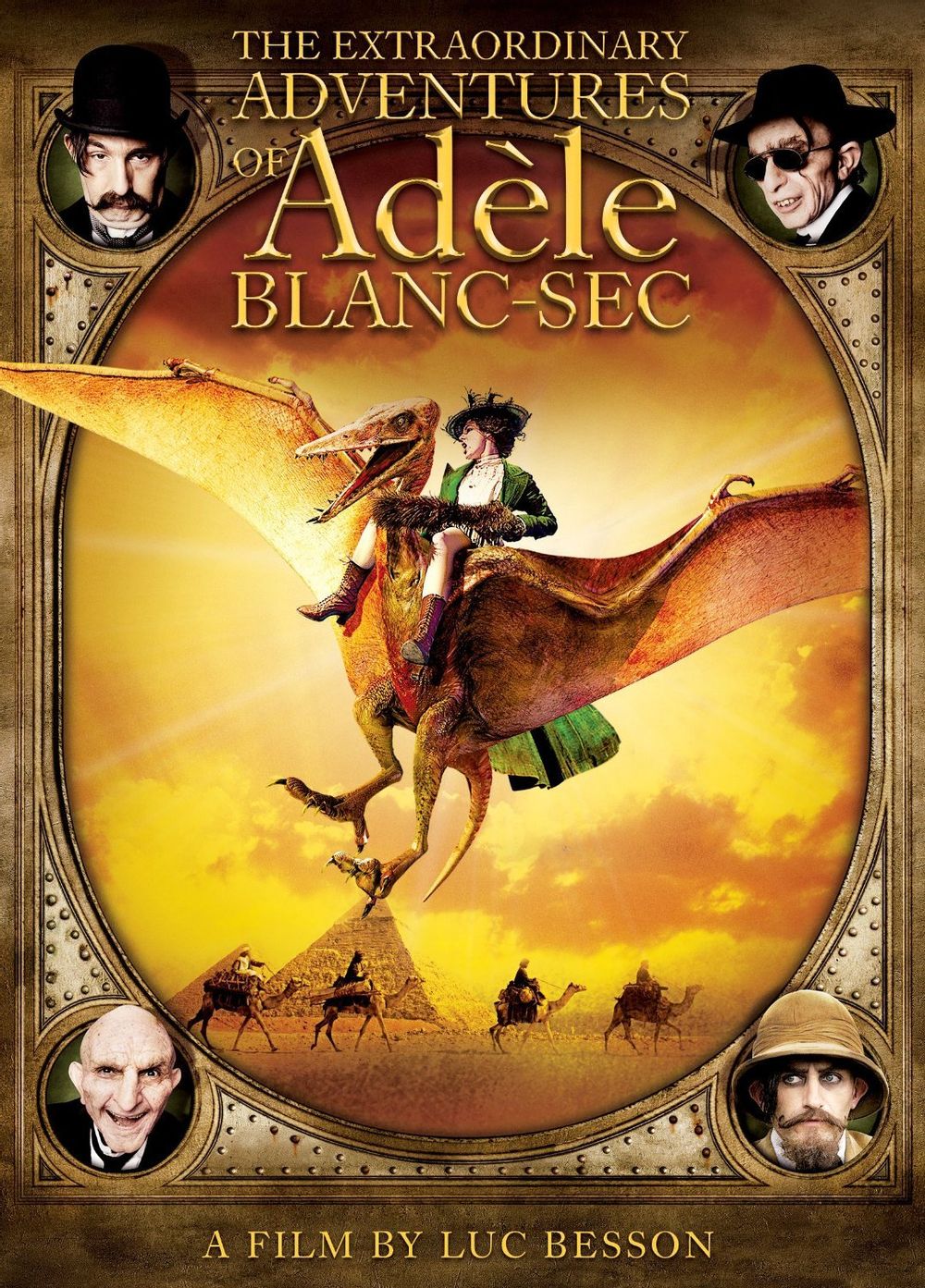
Adèle and the Secret of the Mummy ("Les aventures extraordinaires d'Adèle Blanc-Sec") is a 2010 Luc Besson film starring based on Jacques Tardi's comic series of the same name. It stars Louise Bourgoin as the titular heroine Adèle Blanc-Sec and Mathieu Amalric as her nemesis Dieuleveult.
Set in the late Belle Epoque with steampunk elements, the movie centers on Adèle's quest to retrieve and revive a mummified Egyptian medic to be revived by oddball supernaturalist Espérandieu in order to cure her catatonic sister. By the time she gets back from Egypt, Espérandieu has gotten himself into trouble by resurrecting a petrified pterodactyl egg...
Adèle and the Secret of the Mummy provides examples of:
- Absent-Minded Professor: Pr. Espérandieu. He even refuses rescue from the guillotine because he's too tired to leave the prison.
- Action Dress Rip: Adèle, before riding the pterodactyl.
- Action Girl: Adèle, though she relies on her wits most of the time.
- Adaptational Context Change: In the comic, the professor lives and dies in Lyon without Adèle meeting him. Also, in the comics Adèle was separated from her sister after the death of her parents and did not meet her again until 1922 - nineteen years later.
- Adaptational Heroism: Adèle is still snarky as hell, but compared to the comic she is more sympathetic and less of a Jerkass. Although when captured by Dieuleveult, she leaves her Egyptian hirelings hanging and saves herself.
- Adaptation Name Change: In the comics, Adèle's sister is called Mireille Pain-Sec, here she is called Agathe Blanc-Sec. In the story on which the film's plot is based — Adèle et la bête — the character called Espérandieu in the film is called Boutardieu, while Espérandieu is the name of a character not used in the film.
- And I Must Scream: Played for laughs. Adèle undresses for a bath in front of a mummy, which, unknown to her, is being revived and can see, but not move or speak. After the mummy regains speech and movement, he thanks her for the show.
- Artistic License – History: The Eiffel Tower is shown with its modern brown color. In the 1910s, it should have been red.
- Berserk Button: Don't eat an egg in front of the pterodactyl!
- Big Brother Instinct: The whole movie revolves about Adèle's quest to cure her sister - who got injured during a friendly (albeit competitive) tennis match between sisters
- Chummy Mummy: Patmosis himself. Also, near the end of the film, Professor Espérandieu's ritual is so strong that when it revived Patmosis, it ALSO activated ALL the mummies in the Louvre. Adèle therefore seeks them out in order to help her sister. They eventually decide to see the sights of Paris.
- Dragon Rider: Adèle rides the pterodactyl to save Espérandieu from the guillotine.
- The Edwardian Era: The film is mostly set in 1911 Paris.
- Gratuitous Foreign Language: Adèle learns an Arabic phrase in Egypt that scares horses. It also works on French horses in Paris.
- Great White Hunter: Subverted, as Saint-Hubert turns out to be a great coward.
- Historical Domain Character: Rameses II and Armand Fallières (French president between 1906 and 1913) both appear as supporting characters...
- Historical In-Joke: Pharoah Ramses admires the courtyard of the Louvre, but thinks it would look even better with a pyramid
 in the middle of it.
in the middle of it. - Invincible Hero: Even when escaping a tomb and surviving an impossible plunge down an abyss while locked in a sarcophagus, Adèle is unhurt and just barely disheveled.
- Lost Technology: This film's version of 19th dynasty Egypt was incredibly advanced, starting with the fact that it turns out that Patmosis is a nuclear physicist, not a doctor.
- Master of Disguise: When attempting to break the Professor out of prison Adèle uses a myriad of disguises, all of which fool the guards... Only to be foiled repeatedly by other little matters like the professor being too tired to escape.
- Meaningful Name: Blanc-Sec means "white, dry" ("like the wine", as Adèle helpfully explains); Dieuleveult means "God wills it", Espérandieu means "hope to" or "trust in God".
- Narrator: The film opens with narration by Bernard Lanneau in French.
- Prophetic Name: Justin de Saint-Hubert — St. Hubert is the patron saint of hunters.
- Real Event, Fictional Cause: A somewhat darker Historical In-Joke is that apparently the sinking of the Titanic was an attempt by Dieuleveult to assassinate Adèle.
- Running Gag: Each time Caponi attempts to eat, the pterodactyl does something which makes him stop.
- Shout-Out:
- Aziz, the young Egyptian guide, gets captured by Adèle's enemies in the mummy's tomb. This isn't the first time he's found himself in a surprising situation. In Luc Besson's earlier film The Fifth Element, he was the boy who kept falling asleep in the Egyptian temple ("Aziz, LIGHT!"), who ended up witnessing an alien visitation.
- One of the objects Espérandieu uses for his magic ritual to bring the dead to life is the Arumbaya idol from the Tintin story The Broken Ear.
- Synchronization: As long as he's awake, Espérandieu is linked with the pterodactyl and able to control it. He takes advantage of this to prevent the pterodactyl to cause too much damage. Saint-Hubert eventually manages to shoot the pterodactyl, which kills both the beast and Espérandieu.
